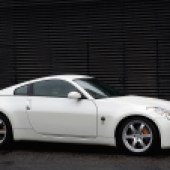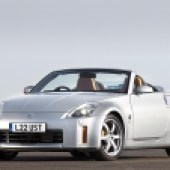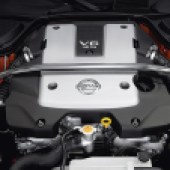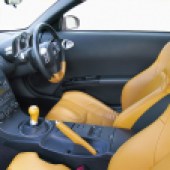Want a brawny sports car offering old-school thrills? The Nissan 350Z is a cracking choice – and one that won’t be getting any cheaper
Words: Chris Randall
The Z badge dates back five decades, the 240Z (or ‘Fairlady’) being launched in 1969, but in the years that followed subsequent models appeared to get larger and softer, prompting enthusiasts to worry that the sports car had become a cruiser. But such concerns were quickly dispelled by the arrival of the 350Z, its notably muscular appearance leaving buyers in no doubt about its sporting intent.
Launched in 2002, the 350Z arrived in the UK the following year with a price tag of £24,000, and the choice of two versions. The entry-level was generously equipped but the majority of buyers stumped up the extra £2500 for the GT Pack which brought the likes of leather trim, an upgraded Bose audio system and cruise control. With rear-wheel drive, meaty-feeling controls and a great soundtrack this was definitely a more purposeful take on the Z-car theme, and the promises made by the styling would be reinforced by a peek under the bonnet, beneath which was a naturally aspirated 3.5-litre V6 making 276bhp.
The new coupe was good for 155mph and a sub-6.0-second 0-62mph time. From 2005 you could savour the same recipe in Roadster form which was barely slower despite the additional reinforcements adding 110kg. A special GT4 edition arrived the same year, taking its name from the Grand Turismo 4 computer game – just 176 came to the UK – and its 296bhp engine was adopted across the range when the 350Z was revised in 2006. A further highlight was the 309bhp HR engine fitted in 2007 which Nissan claimed was 80% new and required a subtle bonnet bulge. A year later the model would make way for its replacement, the 370Z.
Bodywork
Constructed using a steel monocoque with various braces and reinforcements for added rigidity, it’s a sturdy shell although one that may have been compromised by a meeting with the scenery. In over-exuberant hands, plentiful power and rear-wheel drive is a recipe for exiting the road backwards, so it’s well worth checking for any signs of crash repairs. Corrosion shouldn’t be a major concern, but it’s advisable to watch for rust bubbling up around panel edges and in the wheel arches, especially at the rear where rot can get into the end of the sills. And take a good look underneath as rust can take hold in the front sub-frame.
The front end could have become peppered with stone chips, so evidence of localised re-painting isn’t necessarily a worry, but it’s a good bargaining point if attention is needed here. Elsewhere, it’s worth examining the headlights for excessive cloudiness or damage – new ones are £1000 per pair, with good used ones around half that – and check that the tailgate struts haven’t given up. The fuel filler flap release can fail, too, while a Roadster needs checking for any damage to the hood or issues with its electric operation.

Engine and transmission
While the V6 is fundamentally robust and capable of high mileages with scrupulous maintenance – servicing is at 9000 miles/12 months – the 276/296bhp ‘DE’ units in particular have a propensity to use oil to some degree. Catalytic converters essentially mask any blue smoke, so regular level checks are required; if you’re buying privately then ask the owner about their top-up regime. It may have led to a replacement engine earlier in a car’s life, so see if there’s any evidence of this in the records. And on a similar note oil leaks are an issue too, including from the cam cover gaskets which may not be visible externally with the oil collecting in the spark plug wells.
HR engines have an oil gallery gasket that leaks internally, leading to loss of oil pressure, so if it’s below 15psi at idle all’s not well, and although the fix is labour-intensive it’s a must-do. And while there’s no cam belt to worry about regular oil and filter changes, using top-quality lubricant, will reduce premature chain wear. Cracked exhausts (replacement systems can head for £1000) and failed radiator fans are other issues of note, although specialists can fix the latter for around £200.
Some owners also complain of a ticking noise from the engine which can be traced to a worn fuel damper/regulator; there’s two of them, costing around £120 each. Lastly, these engines respond well to ECU re-maps, improving overall driveability rather than just adding unnecessary dollops of power, so ask about any work that’s been done.
Turning to the six-speed manual gearbox, it’s inevitable that a lifetime of use and abuse will take its toll, so check for an obstructive shift and ailing synchromesh, the latter often between and fourth and fifth gears.
Expect to get around 40k miles from the clutch, and if a new flywheel is needed as well you’ll need to budget a nigh-on four-figure sum for replacement. Clutch hydraulics can play-up, too, and HR engines feature a concentric slave cylinder so replacement entails gearbox removal.
Lastly, all UK cars got a limited slip differential so listen out for any grumbles or groans indicating problems, and if the oil-filled mounting bushes fail it causes a vibration from the rear – £250-350 will sort the problem. A clicking from the driveshaft joint axle splines can sometimes be cured by re-packing them with heavy-duty grease.

Suspension, steering and brakes
There’s nothing complicated about the 350Z’s suspension set-up, which means buyers can just concentrate on checking for general wear and tear. Tired bushes are one of the commonest issues and some owners take the opportunity to replace them with polyurethane items, but check the state of springs and dampers, too. In fact, it’s worth checking to see if the car you’re considering is still using OE parts or whether a previous owner has taken the aftermarket route; the latter’s not a problem as long they’ve used quality parts but it can be a good clue as whether they’ve skimped on maintenance.
Up front, a knocking over bumps is likely to point to worn inner bushes or outer ball joints in the compression arms (commonly referred to as ‘banana’ arms) and depending on the quality of the parts used you can be looking at £400-600 for a specialist to replace both sides.
You’ll also want to examine the wheels for signs of corrosion and kerb damage, especially on the desirable and lighter RAYS alloys, and look for unevenly worn or cheap rubber that signifies penny-pinching – OE-spec replacements are recommended. Lastly, if the steering feels notably heavy then it’s probably the power-steering pump on its way out.
Given the performance on offer you certainly don’t want to see any evidence that the brakes have been ignored, so look for scored or corroded discs and feel for any judders on the test drive. Original Brembo parts can be pricey, but opting for top-notch aftermarket pads and discs can see both ends renewed for £400-500. A record of brake fluid replacement every two years is good news – check that caliper bleed nipples aren’t broken – and ensure the ABS warning light goes out.

Interior and trim
While the interior looked the part and featured a great driving position, overall quality was nothing to shout about. Yes, it was all screwed together well enough as you’d expect from Nissan but cheap-feeling plastics abounded, so check that general abuse and clumsiness hasn’t resulted in damage.
Scuffed leather trim and worn seat bolsters are other obvious things to look out for – the optional Alezan Orange upholstery wasn’t to all tastes, either – but unless it’s bad enough to need a professional trimmer then some DIY renovation should suffice.
Naturally, it makes sense to ensure all the electrics are working before parting with any cash; failed electric window motors aren’t uncommon and some owners report niggling faults with the Bose audio system, and given the potential cost of repairs it’d be wise to check the operation of the climate control. Check for air-bag warning lights, too, and for any signs of damp in a Roadster’s cabin.
Nissan 350Z: our verdict
It’s getting harder to find a good Nissan 350Z for less than £5000, so now’s the time to buy as values continue to rise. You’ll pay slightly less for a convertible than a coupe – with the former offering better access to the engine’s very pleasant noise, but the latter a more practical ownership experience. It’s a fine alternative to rivals like the Audi TT.
Ultimately, there’s an addictively old-school feel to the way any 350Z goes about its business, and there’s no shortage of character – so buy well and it’s a car you might find hard to part with. As the market continues its trend of favouring modern classic Japanese sports cars, the Nissan 350Z makes a strong case for itself.
Nissan 350Z timeline
1999
240Z concept shown at the North American Auto Show
2000
Design work on production 305Z at Nissan Design America. Main designer credited at Ajay Panchal, working as part of a team led by Diane Allen
2002
Car launched in its native Japan in July as the Nissan Fairlady Z
American market launch in August as the Nissan 350Z
2003
European-market 350Z introduced with revised suspension courtesy of Nissan Technical Centre Europe in Cranfield, Bedfordshire
2004
350Z Roadster introduced in US
2005
Roadster arrives in Europe
GT4 special edition arrives with more power, special paint options, Rays alloy wheels and even a Playstation 2 complete with a copy of Gran Turismo 4
2006
More powerful engine spec from GT4 now standard across the range
2007
Updates introduced including higher-revving engine and lighter steering, clutch and gearshift
2009
Nissan 370Z arrives as 350Z replacement











